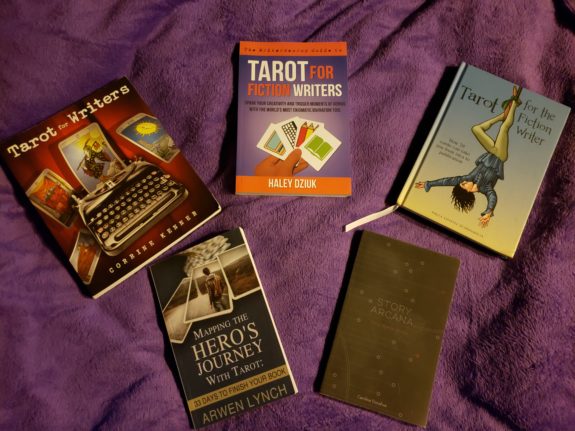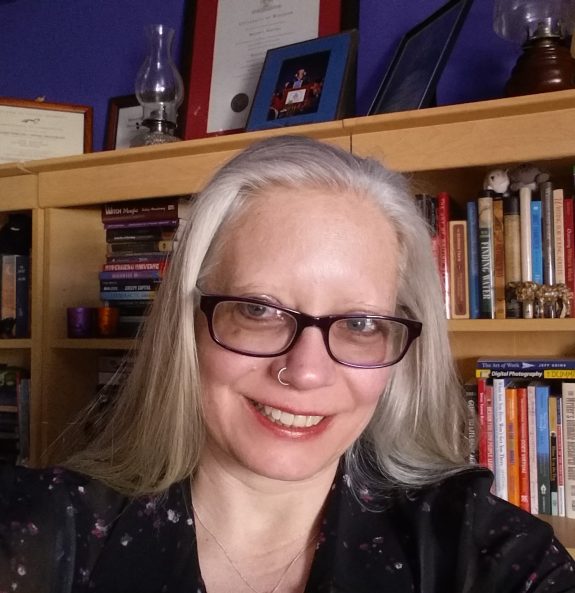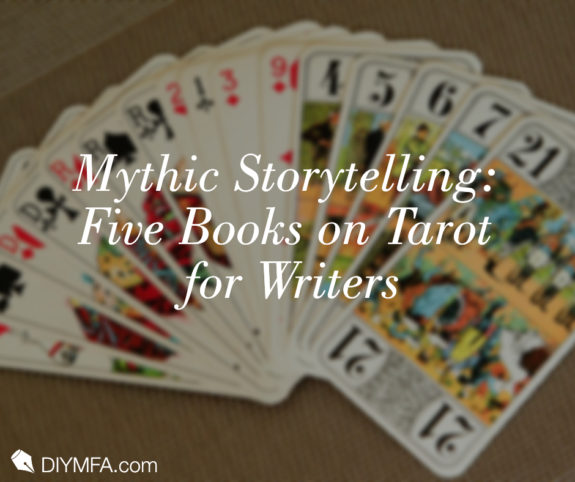Last time on Speculations, I offered a brief introduction to the tarot. This time, I’ve read and will briefly review five books on tarot for writers, so that you can decide which reference(s), if any, you might want to add to your writing craft library.
I’ve decided to present them in chronological order by date of publication, though I will also mention the order I read them in for context.
Commonalities
Before we get into the specifics of each of the five books, there are several qualities or types of content that they have in common.
- Without exception, all the books contain a guide to the meanings of the cards. For some, this guide is restricted to the major arcana. In most, however, there is an appendix or section devoted to both the major and minor arcana.
- All the books discuss spreads. Spreads are specific layouts of the cards that may help uncover their meanings. Some are simple and others are fairly complex.
- Despite the suggested meanings and spreads, every author recommends an intuitive approach to reading the tarot.
And now, the books.

Tarot for Writers
Corrine Kenner wrote Tarot for Writers and it was published by Llewellyn Publications in 2009. It was the last of the five books I read, and I consider it to be one of the best of the books on the subject. It’s also one of the longest at 325 pages, but 206 of those are devoted to the meanings of the major and minor arcana.
Kenner is a practicing tarot reader and wrote several other books on tarot for Llewellyn. She also wrote a book on astrology for writers and includes a chapter on astrology and the tarot in this book. Tarot for Writers is considered to be the foundational work on the topic. Kenner starts with an introductory section on how to read the tarot and classic spreads, and then she progresses to writer-specific topics like character creation, plotting, setting and description, breaking writer’s block, and using the tarot as a writing coach.
If you can only get your hands on one of these books, I recommend it be Tarot for Writers.
Mapping the Hero’s Journey with Tarot
Arwen Lynch wrote Mapping the Hero’s Journey with Tarot in 2017 and she focuses on the Hero’s Journey as set out by Christopher Vogler in his book The Writer’s Journey. It’s a nice, compact volume and very accessible. This is the second book on tarot for writers that I read.
Lynch starts with character building, launches into the Hero’s Journey in three act structure, and then finishes with some discussion of themes and journals before her section on the meanings of the cards and spreads. There is one overarching Hero’s Journey spread, but for each stage, Lynch recommends a simple three card reading specific to the stage of the Hero’s Journey. While she does suggest specific cards that epitomize each step, her system is intended to work equally well with a random drawing of the cards.
If you’re fond of the Hero’s Journey as a mythic storytelling structure, then this is the book for you.
Tarot for Fiction Writers
Tarot for Fiction Writers is a Writersaurus Guide written by Haley Dziuk in 2018. Dziuk readily admits her beginner’s status in using the tarot as a writer. She was so taken with the potential of the tool that she was compelled to commit her newfound knowledge to the page in a guide for writers. This was the third of the five books on tarot for writers that I read.
After an introductory section, Dziuk offers some recommendations on the writer’s choice of deck and tarot journal, a brief overview of learning the meanings of the cards in the context of a spread, making reference to the more detailed section on the card meanings later in the book, and some advice on conducting tarot readings as an author, including how to use them depending upon your orientation on the pantser/plotter spectrum.
She then discusses a few simple spreads, again with reference to resources at the back of the book, using the tarot for story prompts, character development, plot development, world building, and addressing writer’s block. The rest of the book, roughly half, is devoted to resources.
Tarot for Fiction Writers is a good beginning text on the topic, ideal for a writer who wants to dip their toes in the world of tarot without devoting a lot of time or money to the study.
Tarot for the Fiction Writer
Are we seeing a trend here? Tarot for the Fiction Writer was written in 2019 by Paula Chaffee Scardamalia, who uses the tarot professionally as a writing coach and as an author of fiction and non-fiction (so, not a tarot professional advising on writing, or a writer just getting into tarot). It is the most beautiful of the tarot for writing books with full color illustrations throughout and a built-in ribbon bookmark. It was the fourth book I read and, I must confess, my favorite.
Chaffee Scardamalia structures her book on the major arcana and with the framing device of an adventure at sea. The journey is twofold, for the characters of your stories and for you, as the writer. She, too, has a preparatory section regarding choice of deck, the structure of the cards, and spreads, but thereafter groups the cards of the major arcana (singly, in pairs, or threes) using each to illustrate the journey of the character and the journey of the writer. She’s the only author to discuss the book launch, promotion, and marketing as integral parts of the writer’s journey.
This book has it all, though it’s not as comprehensive as Kenner’s in terms of the minor arcana.
Story Arcana
Story Arcana was the first book I read and how I became interested in the topic. The author, Caroline Donahue, is a writer and the woman behind the Secret Library Podcast. I became aware of her and Story Arcana through an interview she did with Joanna Penn on the Creative Penn Podcast last year.
Donahue published Story Arcana in 2019 and uses a similar tactic to Chaffee Scardamalia, covering each of the cards of the major arcana in terms of the character’s and the author’s journeys. There is some introductory material and some information on spreads and other resources at the end, but little discussion of the minor arcana. Like Dziuk, she’s a writer who’s found value in the tarot for her own process and who felt the need to share that knowledge with other writers.
To be honest, it was my least favorite of the books, the others all covering similar ground and often more comprehensively. I did enjoy all the books, however, and I think any one of them will help writers delve into the world of tarot.
If you’re a fan of Donahue or the Secret Library Podcast, I’d encourage you to support her by picking up Story Arcana.
Next Time on Speculations
Originally, I mentioned that I was going to analyze two stories using this mythic storytelling tool as I have with the other structures I’ve discussed in the past, but I’ve realized that’s not going to work. The tarot isn’t a structure per se, but about finding structure/story, overcoming creative confusion, or opening yourself to your intuitive powers as a storyteller.
With that in mind, I’m going to use the Hero’s Journey spread to create the basic outline of a fantasy story.
This is going to be fun. I can’t wait to find out what happens!
Until next time, keep speculating, and see where it leads you!

Melanie Marttila creates worlds from whole cloth. She’s a dreamsinger, an ink alchemist, and an unabashed learning mutt. Her speculative short fiction has appeared in Bastion Science Fiction Magazine, On Spec Magazine, and Sudbury Ink. She lives and writes in Sudbury, Ontario, Canada, where she spends her days working as a corporate trainer. She blogs at https://www.melaniemarttila.ca and you can find her on Facebook and Twitter.







